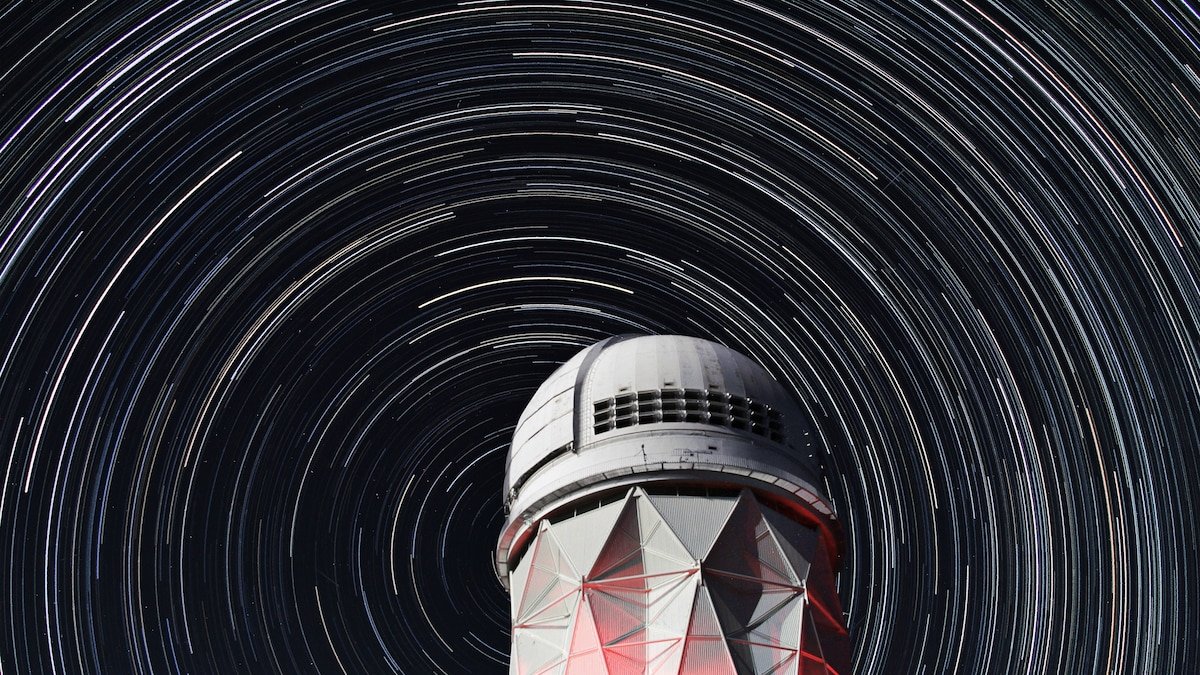If you had asked me a year ago about the most likely ultimate fate of the universe, I would have been able to answer immediately. As a cosmologist, I’ve spent a lot of time thinking about the end of the universe—I even wrote a book on the topic. We know the universe is expanding, and that expansion is speeding up. In the far distant future, this accelerating expansion will empty out the cosmos until there’s essentially nothing left. Stars burn out, matter decays, black holes evaporate, and eventually nothing is left but a few stray particles of light diffusing away the waste heat of all creation. This scenario is sometimes called the “heat death” or the “big freeze”, and it’s a straightforward consequence of our best working theory for how the universe behaves.
But if you asked me today, I would hesitate. The results announced in late March by the Dark Energy Spectroscopic Instrument (DESI), building on a previous data release last year, paint a very different picture of our universe by challenging our best guess as to the nature of its most important—and most mysterious—component: dark energy.
DESI has created the largest 3D map of our universe to date, tracking millions of galaxies. By examining the underlying structure of matter in the universe, the project aims to learn more about the nature of dark energy. In the animation above, Earth is at the center and bluer points indicate more distant objects.
DESI Collaboration/DOE/KPNO/NOIRLab/NSF/AURA/R. Proctor
The origins of dark energy
When dark energy was first discovered, it was, to put it mildly, a surprise.
In the late 1990s, astronomers discovered that the expansion of the universe, initially set off by the big bang, has been subtly speeding up over the last few billion years. The acceleration was clear in the data, and confirmed by multiple groups, but it didn’t seem to make any sense.
Researchers expected expansion to decelerate, not accelerate. Everything in the cosmos—galaxies, stars, gas, dust, even pure energy—has a gravitational effect on everything else. And gravity pulls objects together, never to pushes them apart. So while astronomers have known for more than a hundred years that distant galaxies are moving away from each other, and moving away from us, with the expansion of the cosmos, the only sensible expectation was that the gravity of all that stuff should resist the expansion and, gradually, slow it down.
If the expansion of the universe was accelerating, though, it was as though something was actively stretching space out from within, over and above the residual expansion from the big bang. Nothing known to exist in the universe should be able to do that.
Fortunately for astronomers, Albert Einstein’s theory of gravity—general relativity—offered a potential loophole. While it was still true that no known substance could make the universe accelerate in its expansion, Einstein did leave open the possibility that space itself could do the job. In his equations for the evolution of the cosmos, he added a term called a “cosmological constant” —depicted as the Greek letter Λ or “lambda”—that essentially gave space itself the ability to swell from within and push back against gravitational collapse.
When Einstein first proposed it, astronomers didn’t know the universe was expanding. Once observations pointed to an expanding universe, he took the term out of his equations, wrote it off as a mistake, and moved on to more sensible things.
When faced with their unexpected observations of acceleration, modern astronomers thought that perhaps the cosmological constant could explain the unexpected stretching of space. Bizarre as it was, it did.
The cosmological constant also presented a compelling timeline. Back when the universe was smaller and denser, gravity was gradually slowing the expansion, and the cosmological constant didn’t have much effect. But as soon as the universe became big and diffuse enough, about six billion years ago, all that extra empty space meant that the tiny bit of stretching tendency could take over, causing the expansion to speed back up.
For the last few decades, every observation seemed to be in reasonable agreement with this narrative, so physicists integrated a cosmological constant into their model of how the universe works. The cosmological constant falls under the umbrella of the more generic term dark energy, which refers to anything that causes cosmic acceleration and encompasses the possibility of a cosmological constant or something even weirder.
You May Also Like
A cosmological constant—or something weirder?
By keeping the definition of dark energy broad, we’ve also kept an open mind for other explanations. Maybe dark energy isn’t an inherent property of space, but actually some kind of as-yet unknown energy field (sometimes called “quintessence” or “dynamical dark energy”). This field could be acting like a cosmological constant now—stretching space in just the same way—but instead of being a constant property of space, it might be something that changes with time, either growing weaker or stronger as the universe evolves.
Figuring out what exactly is happening with dark energy, and whether it really is a cosmological constant, has been the driving motivation for several major observational projects in recent years, including DESI. Whatever dark energy is, by our best astrophysical accounting, it makes up something like 70 percent of the energy density of the universe. It’s the most important thing in the cosmos, both in terms of its amount and in terms of its influence on cosmic evolution.
If dark energy is a cosmological constant, the heat death scenario where the universe ends dark and cold and empty is virtually assured. We can calculate how long it will be before distant galaxies are pulled away from us so fast we can no longer see them (about 100 billion years), and we can determine how long it will be before the cosmos fully succumbs to its own inevitable decay (the number is too big to easily express in words).
Since DESI’s results have come out, though, people have been asking how that picture might change.
Constants aren’t supposed to change
The DESI results appear to agree better with a kind of dark energy that gets weaker over time than with a cosmological constant. The results are pretty compelling but not yet what we in physics would call a “discovery”. If the finding is correct, the expansion is still accelerating, but not as much as it was when dark energy first began to dominate. That’s definitely not how a cosmological constant works.
Some news stories about the results have suggested that this is reason for a certain kind of optimism. Maybe the heat death isn’t our fate after all. Perhaps the weakening of dark energy means that the expansion will enter a coasting phase, or eventually stop altogether. Some have even floated the idea that this evolving dark energy could weaken so much that it becomes an attractive force, reversing expansion completely and leading to a “big crunch”.
Personally, I would advocate quite a bit more caution in these interpretations. Even if DESI’s results completely hold up to scrutiny and are confirmed by other surveys, they give us essentially no information about the future. The only reason we can make inferences about our fate with a cosmological constant is that we know exactly how it behaves: It’s constant. With dynamical dark energy, though, until we know what drives its evolution, we have no handle on what will happen next.
Maybe we’ll get something else entirely. Taken at face value, the DESI results suggest that in an earlier epoch, dark energy was in what physicists call the “phantom” regime. Phantom dark energy is dark energy that gets more powerful over time in a way that can literally rip the universe apart. If it really was phantom in the past, there’s nothing to say it can’t shift that direction again, potentially leading to a rather ghastly fate called the “big rip.” On the theory side, there are reasons to doubt that phantom dark energy can happen at all, but if it can, it doesn’t exactly inspire optimism.
What happens if dark energy disappears?
I should say that even if dark energy weakens so much that it disappears entirely, and even if expansion completely stops, that’s also not necessarily a reprieve. Stars will still explode or fade away as the hydrogen they contain is converted into helium in their cores. Black holes will grow and eventually evaporate. And one way or another the cosmos will tend toward disorder and decay, as some of our most reliable physical laws require. It’s also possible that an entirely different fate could befall us, driven by a quantum shift in the laws of physics: a weird and decidedly un-survivable phenomenon known as vacuum decay.
If dark energy really does go away, and if vacuum decay doesn’t happen, some slim prospects for keeping anything like life going in an expanding universe might theoretically exist, but I’d say they’re more technical than practical. There just isn’t a lot of room in our current understanding of cosmology for a happily-ever-after.
Personally, I’m excited to see how this debate develops, despite the bleak prognosis. DESI’s results could lead to the first major cosmological paradigm shift since dark energy was discovered, and a complete rewriting of our model of the universe.
Dark energy will probably destroy everything, eventually. But in the meantime, the quest to understand it has driven some incredible discoveries. And there’s no telling what the universe has in store for us next.











